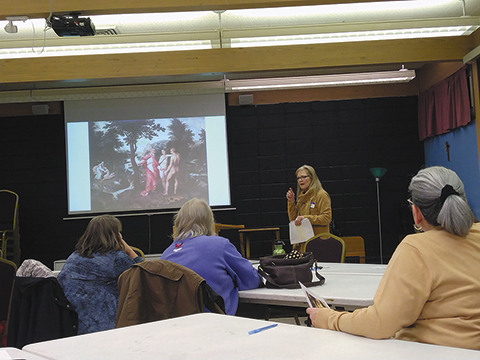
VERONA — January 16 saw St. Christopher Parish in Verona host the first of a new series: “Revealing the Mystery”.
Beth Ptak, artist and art teacher, and Susan Swanke, coordinator of adult formation at St. Christopher and student of the Theology of the Body, are heading up the series.
It combines St. John Paul II’s Theology of the Body with meditations on art, particularly in light of the pope’s “Letter to Artists”.
The series is being presented over several weeks, with each week highlighting a particular piece of art and including time for discussion and reflection as well as Ptak’s and Swanke’s presentations.
The basic thesis
The first session focused on what Swanke termed “essentially the basic thesis of Theology of the Body.”
“The body . . . has been created to transfer into the visible reality of the world the mystery hidden from eternity in God, and thus to be a sign of it.” (Theology of the Body 19:4)
The session introduced the concept of creation, and especially the human body, as a visible sign of the invisible God.
This applies to creation itself, especially man and woman, and also to Christ — Christ is literally God made visible, the Word made Flesh.
This idea of creation as a sign of God provided fertile ground for meditation and discussion on the ways human love can reflect divine love and on the goodness of creation itself.
It also set the stage for a segue to the art under discussion.
Swanke commented that art and the written word complement each other, and the Church’s mission requires both. St. John Paul II said, “In order to communicate the message entrusted to her by Christ, the Church needs art.” (“Letter to Artists,” 12)
A closer look at art
If creation is a visible sign of God, then art — the creations of man — also reflects God’s message.
The group was invited to study a work by Jacob de Becker, who was a Flemish Mannerist painter in the 1500s.
His piece Garden of Eden is a stunningly rich image of creation before the Fall, with God, Adam, and Eve at the center of an abundance of teeming life.
After Ptak had illuminated some of the artistic elements of the painting, giving insights into its composition and method of painting, time was given for personal reflection.
Swanke encouraged those there to pray with the piece and discover what God might be trying to say to them personally, as well as considering what it said from an intellectual perspective.
The concluding discussion was a fruitful collaboration of different insights, examining the various small details in the painting that lend themselves to prayer.
It was pointed out that the animals surrounding Adam and Eve, and the sheer size of the location, reflect God’s generosity in providing the Garden of Eden.
Several people commented that the painting creates a longing in the viewer for such a place of peace.
The positioning of the figures, on the other hand, tells a story of reluctance — God reaches out to Adam far more than Adam reaches back.
Although not everything about the painting appealed to everyone, it was clear that God’s message is revealed in this piece.
The hour-and-a-half session was a unique way to nourish one’s relationship with God — and well worth attending, despite the foggy conditions.
For those who wish they could have come, feel free to check out the rest of the series — while the nightly sessions discuss similar themes, they are not strictly sequential, so joining in late is no problem.
The series will run Monday nights through February 13.
St. Christopher Parish at St. Andrew Church is located at 301 N. Main St., Verona.

